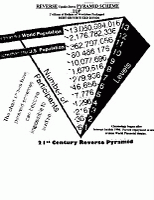Countries everywhere are facing debt crises today, precipitated by the credit collapse of 2008. Public services are being slashed and public assets are being sold off, in a futile attempt to balance budgets that can't be balanced because the money supply itself has shrunk. Governments usually get the blame for excessive spending, but governments did not initiate the crisis. The collapse was in the banking system, and in the credit that it is responsible for creating and sustaining.
Contrary to popular belief, most of our money today is not created by governments. It is created by private banks as loans. The private system of money creation has grown so powerful over the centuries that it has come to dominate governments globally. But the system contains the seeds of its own destruction. The source of its power is also a fatal design flaw.
The flaw is that banks advance "bank credit" that must be paid back with interest, while having no obligation to spend the interest they collect so that borrowers can earn it again and again, as they must in order to retire the debt. Instead, this money is invested in various casinos beyond the borrowers' reach. This leads to a continual systemic need for more new bank credit money, more debt with more interest attached, to prevent widespread defaults and deflationary collapse.
Today this problem is particularly evident in the EU. The Euro is a fixed currency system that does not allow for expansion to meet the demands of the private lending casino. The result is that EU member nations collectively are being crippled by debt.
There are more sustainable ways to run a banking and credit system, as will be shown.
How Banks Create Money
The process by which banks create money was explained by the Chicago Federal Reserve in a booklet called "Modern Money Mechanics." It states:
"The actual process of money creation takes place primarily in banks." [p3]
"[Banks] do not really pay out loans from the money they receive as deposits. If they did this, no additional money would be created. What they do when they make loans is to accept promissory notes in exchange for credits to the borrowers' transaction accounts. Loans (assets) and deposits (liabilities) both rise [by the same amount]." [p6]
"With a uniform 10 percent reserve requirement, a $1 increase in reserves would support $10 of additional transaction accounts." [p49]
A $100 deposit supports a $90 loan, which becomes a $90 deposit in another bank, which supports an $81 loan, etc.
That's the conventional model, but banks actually create the loans FIRST. (Picture how a credit card works.) Banks need deposits to clear their outgoing checks, but they find the deposits later. Banks create money as loans, which become checks, which go into other banks. Then, if needed to clear the checks, they borrow the money back from the other banks. In effect, they borrow back the money they just created, pocketing the spread between the interest rates as their profit. The rate at which banks can borrow from each other in the U.S. today (the Fed funds rate) is an extremely low 0.2%.
How the System Evolved
The current system of privately-issued money is traced in "Modern Money Mechanics" to the 17th century goldsmiths. People who left gold with the goldsmiths for safekeeping would be issued paper receipts for it called "banknotes." Other people who wanted to borrow money were also happy to accept paper banknotes in place of gold, since the notes were safer and more convenient to carry around. The sleight of hand came in when the goldsmiths discovered that people would come for their gold only about 10% of the time. That meant that up to ten times as many notes could be printed and lent as the goldsmiths had gold. Ninety percent of the notes were basically counterfeited.
This system was called "f ractional reserve " banking and was institutionalized when the Bank of England was founded in 1694 . The bank was allowed to lend its own banknotes to the government, forming the national money supply. Only the interest on the loans had to be paid. The debt was rolled over indefinitely.
(Note: You can view every article as one long page if you sign up as an Advocate Member, or higher).






